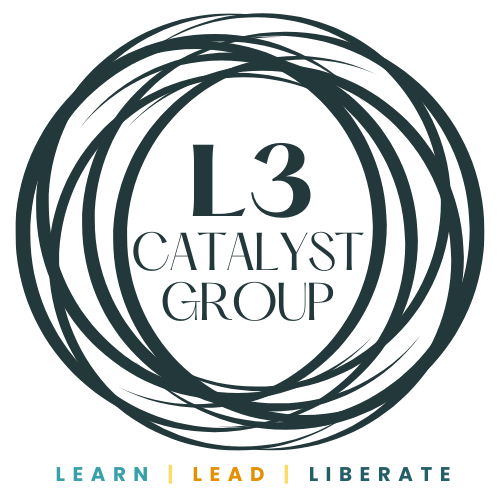I first worked with John P. Kotter’s 8-Steps for Leading Change when I was with Partners in School Innovation in San Francisco. It transformed how I experienced and led change.
We partnered with school and district teams—from the classroom to the superintendency—not to update lesson plans or run new initiatives. We worked to align entire complex systems toward racial equity and high achievement, centering students. We didn't just engage minds, but aligned hearts and habits.
John Kotter’s 8-Step framework helped us understand that transformation isn’t just possible—it’s structured, strategic, and deeply human in a world designed for breakneck speeds.

The First Spark: How Equity-Centered Leaders Ignite Lasting Change
That work at Partners in School Innovation shaped me. And now, at L3 Catalyst Group, it's a model we continue to use.
Over the next few blog posts, we’re revisiting Kotter’s framework through the lens of liberatory leadership and equity-driven change. Today's post focuses on the first three steps of Kotter's change process, adapted from Leading Change (Kotter, 1996) and expanded in Accelerate (Kotter, 2014) and the 8 Steps eBook (Kotter, 2018):
-
Create a Sense of Urgency
-
Build a Guiding Coalition
-
Form a Strategic Vision and Initiatives
Let’s dive in.

Step 1: Create a Sense of Urgency (Without Panic or Burnout)
Kotter argues that most transformations fail because urgency is either missing or manufactured through fear instead of hope (Kotter, 1996; 2018). In liberatory leadership, urgency isn’t about panic—it’s about purpose.
Equity work can’t be postponed. The window to transform culture, systems, and outcomes is open now—but it won’t stay open forever. The question is: can your team feel what’s at stake?
At L3 Catalyst Group, we help leaders frame urgency in ways that are emotionally resonant and strategically focused. We ask:
-
What injustice or harm persists if we don’t act?
-
What is the opportunity this moment offers?
-
What becomes possible if we lead with love and a vision for more equitable accessability and outcomes?
True urgency inspires collective agency, not individual stress. As Kotter says, “You can’t speed up change unless you build urgency that connects both head and heart” (Kotter, 2018, p. 10).

Step 2: Build a Guiding Coalition (Not Just Another Committee)
Kotter emphasizes that transformational change requires a diverse group of stakeholders empowered to lead the charge (Kotter, 2018, p. 13). These aren’t just executives—they’re the people who carry trust, influence, and insight across your organization.
Lets go a step further. A guiding coalition for equity should include:
-
Voices from historically marginalized communities
-
Those who are informal influencers—not just formal leaders
-
Cross-functional representatives who understand operations, culture, and relationships
This is where the shift from symbolic diversity to strategic inclusion begins.
As Kotter reminds us, "You need more eyes to see, more brains to think, and more hands to do" (Kotter, 2018, p. 14). And we’d add: more hearts to feel where harm lives and where healing can begin.
Step 3: Form a Strategic Vision (That Inspires Action, Not Just Agreement)
A strong vision gives people something to move toward—not just something to critique. Kotter defines a strategic vision as “communicable, desirable, flexible, and emotionally compelling” (Kotter, 2018, p. 16).
Too often, equity work stalls because the “why” isn’t clear or the goals aren’t grounded in shared values.
Leaders develop equity visions that:
-
Name specific systems or practices that must shift
-
Include both outcome and process goals (e.g., how we’ll do the work is as important as what we achieve)
-
Are co-created with people impacted by the change
Data alone won’t move people. “You must also account for how people feel. If you can provide greater meaning and purpose to their efforts, amazing things are possible” (Kotter, 2018, p. 17).
We’ve seen it firsthand—vision rooted in justice creates momentum that compliance never could.

The First Steps Matter Most
Fear, anxiety, and urgency are all around us and within us. Without intention and joint focus they can rule us.
Centered leaders and teams engage their clear sense of purpose, grow a coalition that reflects their whole organization, and a vision that inspires both strategy and spirit. That’s how transformational change begins.
This isn’t theoretical for us—it’s personal. It’s real. And it works.

Stay tuned for our next post on Kotter's Steps 4–5: Enlist a Coalition + Remove Barriers. We’ll dig into how to move from vision to movement.
Until then, let's ask:
-
Where are we creating urgency?
-
Who’s in the room shaping the future?
-
Can our people feel what we’re fighting for?
If you want to explore this framework more deeply in your context, we’re here—not to sell you something quick, but to build something lasting.
Because leadership rooted in love, aligned with equity, and shaped by liberation? That’s the kind that transforms systems.
Fellow leaders and learners, I wish you courage, rest, and Beloved Community for the journey. Together we catalyze a brave, bold, and liberatory future.
.png?width=116&height=58&name=Dee%20(1).png)
References/Sources:
Kotter, J. P. (1996). Leading Change. Harvard Business School Press.
Kotter, J. P. (2014). Accelerate: Building Strategic Agility for a Faster-Moving World. Harvard Business Review Press.
Kotter Inc. (2018). 8 Steps to Accelerate Change in Your Organization [eBook]. Retrieved from https://www.kotterinc.com

September 3, 2025





Comments